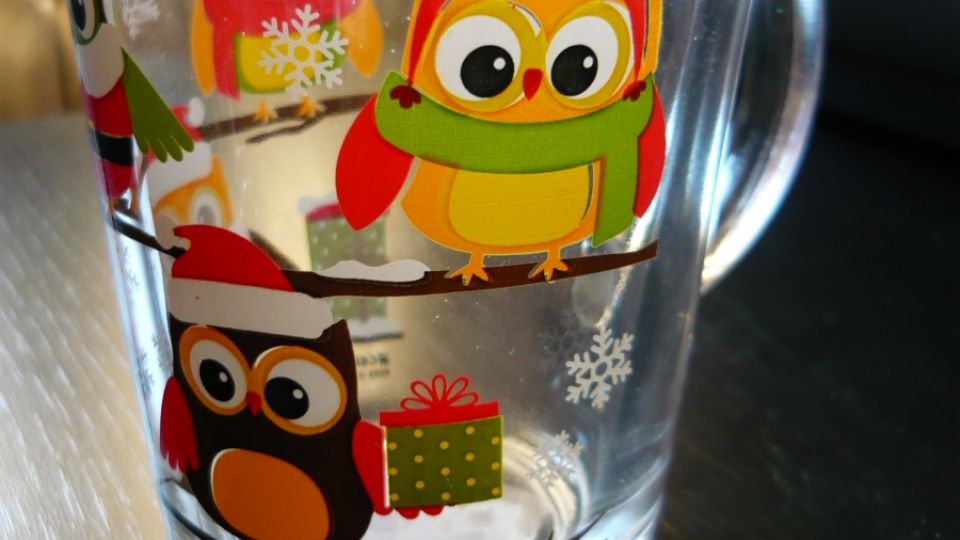Popular soft summer drinks - regardless whether it is a raspberry-flavoured lemonade, ice coffee or mojito - may become "more heavy" when we drink it. However, the culprits are not the drinks themselves, but the glasses that very often contain toxic heavy metals in colour prints. Arnika, within the framework of the Let's Eat Toxics Free campaign, analysed several dozens of printed glasses. About two thirds of them contained high concentrations of lead and cadmium. In comparison with china dishes (examined by Arnika in the past), even twice as high lead amounts were often found in prints on glasses.
Even colours used for printing pictures for children are not an exception. Nevertheless, Arnika found that safe alternatives exist to these colours containing toxic substances. Some manufacturers and sellers even use them voluntarily and systemically already. However, a majority of them still uses problematic colours. Also the legislation is imperfect and enables them to do that. This may be changed, in particular, by a pressure of consumers.
A table with measurement results may be found here>>
„Use of neurotoxic lead and carcinogenic cadmium in prints on glasses is not justifiable in the situation when alternatives are available on the market. Such toxic metals should not be present in the goods that come into contact with food at all. However, a majority of manufacturers do not care of our health and observe only the limits set by the legislation,“ explains the head of the Let's Eat Toxics Free campaign, Karolína Brabcová.
From several dozens of the examined glasses, approximately two thirds contained high lead and cadmium concentrations. Often, even more than 40 000 parts per million (1) of lead were found by point measurement using XRF X-ray spectrometer. These values are, in average, about two-times higher than the ones found by Arnika in china dishes in May - and already those results were shocking, in the negative sense. In spite of that, even the present results do not exceed legislation limits, paradoxically.
„Our results are all the more alarming, because the prints are applied to glass at lower temperatures than pigments in china glaze. At the same time, it is usual that they peel off during use, either through washing in a dishwasher, or through scratching,“ says Jitka Straková from Arnika, a heavy metal expert.
Should we assess the glasses according to another legislative regulation (COMMISSION REGULATION (EU) 2015/628), the limit for lead content would be exceeded 80-times, and such glasses would not be allowed to be placed on our market at all. Unfortunately, this regulation applies to articles that „may be placed in the mouth“, however, it does not apply to glasses.
Samples of glasses with higher lead contents were obtained mostly in smaller shops with household goods in the centre of Prague, and in bigger chains, such as the shop with household accessories Nanu Nana.
An approach different from the majority of glass manufacturers and sellers is taken by IKEA: „We want to have a positive influence on people and the planet through all we do, and we also want to contribute to reduce spreading hazardous substances. Because of that, we use materials, surface treatments, and manufacturing processes, showing the lowest possible environmental impacts. Production of glass and ceramic products without addition of lead‑containing pigments does not influence product quality anyhow, and, because of that, we have used lead-free prints since 2006. Nowadays, the same colours may be obtained by using organic colouring agents, for which lead- and cadmium-containing pigments had to be used in the past. From the points of view of costs and manufacturing complexity, the demands are the same. The only difference is that lead glass shows higher refractive index than the lead‑free one, and, thus, it is more glossy,“ says Vladimír Víšek from the company IKEA.
Pressure of the consumers is essential now. The appeal Let's Eat Toxics Free! may be signed by anybody who wants to persuade our manufacturers, importers and sellers of dishes that avoiding toxic substances in their products and goods is worth it. The alternatives are not only technically feasible, but also verified by the market already - as proved by the positive exceptions. According to Arnika, continued use of colours containing heavy metals is unfounded, and, in a sense, even unpardonable.
Notes:
1) ppm: units stating concentration of the monitored substance or element (in the present case, lead or cadmium), per a million parts of the analysed material (in the present case, the colour printing).







